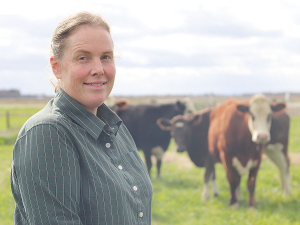Tactical use of AI
A major player in this project is LIC with Beef Genetic Product Lead, Paul Charteris pointing out his organisation have the majority market share in terms of inseminations of dairy cows.
 Professor Rebecca Hickson says that no one breed of bull is better than the other – it’s the traits and the genetics that counts.
Professor Rebecca Hickson says that no one breed of bull is better than the other – it’s the traits and the genetics that counts.
Rebecca Hickson says no one breed of bull is better than the other – it’s the traits and the genetics that counts. She says there are good and poor performing bulls in every breed, so understanding the traits of any bull should be the focus.
“When you look at the question of should you use a bull or a straw, there’s a whole lot of things at play. I believe that if you use a straw, use a good one that will deliver for you and for the most part won’t cost more,” she says.
But she adds, if a farmer is going to use a bull, they should use a good one. Hickson says farmers have told her they don’t need genetics because they feed their calves well. But she notes that while better feeding will always give you a better animal, even on a lower nutrition plain, better genetics will always outperform lower genetics.
When rearers are selecting calves, Hickson says there is sometimes a tendency to select the bigger calf over the smaller one. But she says there is no guarantee that a bigger calf will grow into a bigger animal and there is data to suggest that the small calf may in many cases be the best bet.
“This is because the beef breeders have done a phenomenal job of creating ‘curve bender bulls’ – meaning that while a calf may be born small, it will grow fast, will calve easily, but is at least, if not more valuable than the larger calf,” she says.
Hickson says farmers, calf rearers and finishers who have long standing, close relationships do their best and this is the pathway to producing better beef animals. She says she’d encourage farmers when they are picking the straw for their dairy cows to not only look after their own needs, but to think about others down the value chain.
Fonterra shareholders say they will be keeping an eye on their co-operative's performance after the sale of its consumer businesses.
T&G Global says its 2025 New Zealand apple season has delivered higher returns for growers, reflecting strong global consumer demand and pricing across its Envy and Jazz apple brands.
New Zealand's primary sector is set to reach a record $62 billion in food and fibre exports next year.
A new levying body, currently with the working title of NZWool, has been proposed to secure the future of New Zealand's strong wool sector.
The most talked about, economically transformational pieces of legislation in a generation have finally begun their journey into the statute books.
Effective from 1 January 2026, there will be three new grower directors on the board of the Foundation for Arable Research (FAR).